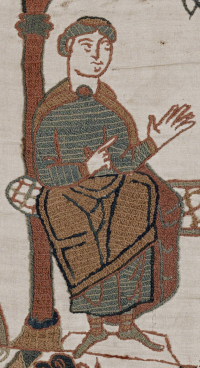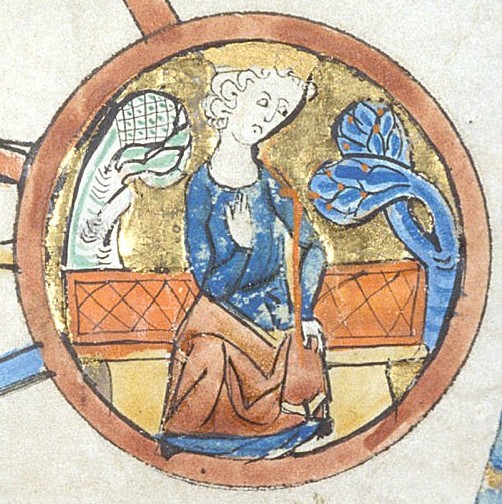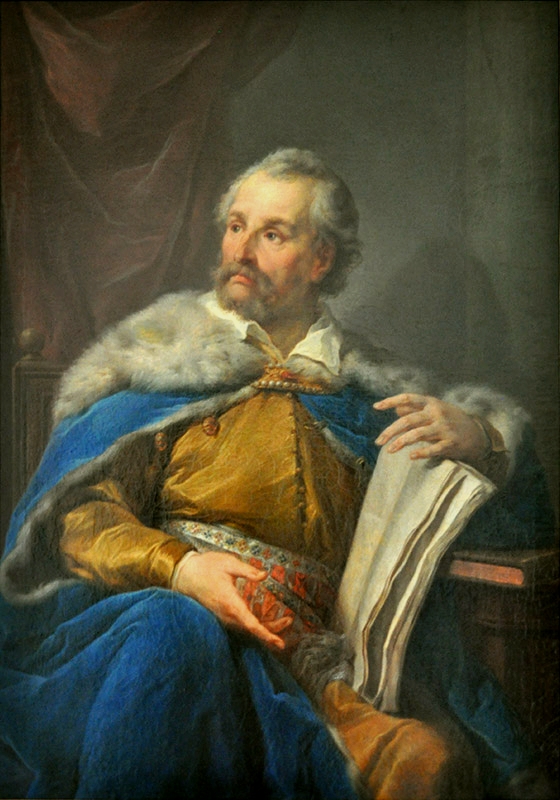|
Robert Of Bellême, 3rd Earl Of Shrewsbury
Robert de Bellême ( – after 1130), seigneur de Bellême (or Belèsme), seigneur de Montgomery, viscount of the Hiémois, 3rd Earl of Shrewsbury and Count of Ponthieu, was an Anglo-Norman nobleman, and one of the most prominent figures in the competition for the succession to England and Normandy between the sons of William the Conqueror. He was a member of the powerful House of Bellême. Robert became notorious for his alleged cruelty. Referring to his activities in the rebellion against Henry I of 1110–1112, the chronicler Orderic Vitalis, in Book XI of his ''Historia Ecclesiastica'', calls Robert "grasping and cruel, an implacable persecutor of the Church of God and the poor ... unequalled for his iniquity in the whole Christian era", as well as "the tyrant who had disturbed the land and was preparing to add still worse crimes to his many offences of plundering and burning". The stories of his brutality may have inspired the legend of Robert the Devil. Early life ... [...More Info...] [...Related Items...] OR: [Wikipedia] [Google] [Baidu] |
Agnes Of Ponthieu
Agnes of Ponthieu (c. 1080 – aft. 1105) was ruling Countess of Ponthieu from 1100. She was the daughter of Count Guy I of Ponthieu and Adela. Enguerrand, her brother, died at a youthful age. Her father, Guy, then made her uncle Hugh heir presumptive, but he also died before Guy (died 1100). Agnes became count Guy's heiress, and was married to Robert of Bellême. Their son William III of Ponthieu succeeded to the county of Ponthieu Ponthieu (; ; ) was one of six feudal counties that eventually merged to become part of the Province of Picardy, in northern France.Dunbabin.France in the Making. Ch.4. The Principalities 888-987 Its chief town is Abbeville. History Ponthieu p ... after the death of Agnes (between 1105 and 1111), and the imprisonment of his father in 1112. References Sources * Counts of Ponthieu Ponthieu, Agnes of French countesses 12th-century countesses regnant 11th-century French women 11th-century French nobility 12th-century French women ... [...More Info...] [...Related Items...] OR: [Wikipedia] [Google] [Baidu] |
Odo Of Bayeux
Odo of Bayeux (died 1097) was a Norman nobleman who was a bishop of Bayeux in Normandy and was made Earl of Kent in England following the Norman Conquest. He was the maternal half-brother of duke, and later king, William the Conqueror, and was, for a time, William's primary administrator in the Kingdom of England, although he was eventually tried for defrauding William's government. It is likely Odo commissioned the Bayeux Tapestry, a large tableau of the Norman Conquest, perhaps to present to his brother William. He later fell out with his brother over Odo's support for military adventures in Italy. William, on his deathbed, freed Odo. Odo died in Palermo, Sicily, on the way to crusade. Early life Odo was the son of William the Conqueror's mother Herleva and Herluin de Conteville. Count Robert of Mortain was his younger brother. There is uncertainty about his birth date. Some historians have suggested he was born around 1035. Duke William made him bishop of Bayeux in 1 ... [...More Info...] [...Related Items...] OR: [Wikipedia] [Google] [Baidu] |
Saint-Céneri-le-Gérei
Saint-Céneri-le-Gérei () is a commune in the Orne department in north-western France. It lies on the river Sarthe from Alençon, the chef-lieu of the department, and some west of Paris. It is classed as a Petites Cités de Caractère. History The place is named for Serenicus (or ''Genericus''), an Italian hermit who lived here during the 7th century. Known today as Saint Céneri, the Italian monk is reputed to have settled here after a long journey, when he experienced a miracle in answer to his prayer for water to quench his thirst. According to legend the so-called miraculous spring, located near the banks of the River Sarthe and today covered by a small stone shelter topped with a cross, sprang up in answer to his prayer. It came to be believed that water from the spring had the ability to cure eye problems. When he died, a monastery was built, later destroyed by the Vikings in 903. The church was a dependency of the abbey of Saint-Evroult-en-Ouche. The name le ... [...More Info...] [...Related Items...] OR: [Wikipedia] [Google] [Baidu] |
Ballon, Sarthe
Ballon () is a former Communes of France, commune in the Sarthe Departments of France, department in the Regions of France, region of Pays de la Loire in north-western France. On 1 January 2016, it was merged into the new commune of Ballon-Saint-Mars. 7 August 2015 See also *Communes of the Sarthe department *Château de BallonReferences External links Former communes of Sarthe {{Sarthe-geo-stub ...[...More Info...] [...Related Items...] OR: [Wikipedia] [Google] [Baidu] |
Neuilly-la-Forêt
Neuilly-la-Forêt () is a former commune in the department of Calvados in the Normandy region in northwestern France. On 1 January 2017, it was merged into the commune Isigny-sur-Mer. 8 September 2016 Population See also *Communes of the Calvados department
The following is a list of the 526 Communes of France, communes of the Calvados (department), Calvados Departments of France, department of France.
The communes cooperate in the following Communes of France#Intercommunality, intercommunalities ...
References ...[...More Info...] [...Related Items...] OR: [Wikipedia] [Google] [Baidu] |
Bayeux
Bayeux (, ; ) is a commune in the Calvados department in Normandy in northwestern France. Bayeux is the home of the Bayeux Tapestry, which depicts the events leading up to the Norman Conquest of England in 1066. It is also known as the first major town secured by the Allies during Operation Overlord after D-Day. Charles de Gaulle made two famous speeches in this town. Administration Bayeux is a sub-prefecture of Calvados. It is the seat of the arrondissement of Bayeux and of the canton of Bayeux. Geography Bayeux is located from the coast of the English Channel and north-west of Caen. The city, with elevations varying from above sea level – with an average of – is bisected by the River Aure. Bayeux is located at the crossroads of RN 13 and the train route Paris-Caen-Cherbourg. The city is the capital of the Bessin, which extends north-west of Calvados. Bayeux station has rail connections to Caen, Cherbourg, Granville and Paris. The river Aure flows throug ... [...More Info...] [...Related Items...] OR: [Wikipedia] [Google] [Baidu] |
Henry I Of England
Henry I ( – 1 December 1135), also known as Henry Beauclerc, was King of England from 1100 to his death in 1135. He was the fourth son of William the Conqueror and was educated in Latin and the liberal arts. On William's death in 1087, Henry's elder brothers Robert Curthose and William Rufus inherited Duchy of Normandy, Normandy and England, respectively; Henry was left landless. He purchased the County of Cotentin in western Normandy from Robert, but his brothers deposed him in 1091. He gradually rebuilt his power base in the Cotentin and allied himself with William Rufus against Robert. Present in England with his brother William when William died in a hunting accident, Henry seized the English throne, promising at his coronation to correct many of William's less popular policies. He married Matilda of Scotland and they had two surviving children, Empress Matilda and William Adelin; he also had many illegitimate children by his numerous mistresses. Robert, who invaded from ... [...More Info...] [...Related Items...] OR: [Wikipedia] [Google] [Baidu] |
Safe Conduct
Safe conduct, safe passage, or letters of transit, is the situation in time of international conflict or war where one state, a party to such conflict, issues to a person (usually, an enemy state's subject) a pass or document to allow the enemy alien to traverse its territory without harassment, bodily harm, or fear of death. Safe conduct is only granted in exceptional circumstances. It may be given to an enemy to allow retreat (military), retreat under Surrender (military), surrender terms, or for a meeting to negotiate; to a stateless person; or to somebody who for some reason would normally not be able to pass. A vanquished enemy can also be given, or offered quarter, i.e. be spared, be promised or guaranteed mercy. The term 'safe conduct' is also used to mean the document authorizing this security. In Islamic law, safe conduct or pledge of safety (''Aman (Islam), amān'') can be granted to foreigners or dhimmi residents (''musta'min'') while they travel or reside in Islamic ... [...More Info...] [...Related Items...] OR: [Wikipedia] [Google] [Baidu] |
Rochester Castle
Rochester Castle stands on the east bank of the River Medway in Rochester, Kent, South East England. The 12th-century keep or stone tower, which is the castle's most prominent feature, is one of the best preserved of its time in England or France. Situated on the River Medway and Watling Street, Rochester was a strategically important royal castle. During the late medieval period, it helped protect England's south-east coast from invasion. The first castle at Rochester was founded in the aftermath of the Norman Conquest. It was given to Bishop Odo, probably by his half-brother William the Conqueror. During the Rebellion of 1088 over the succession to the English throne, Odo supported Robert Curthose, the Conqueror's eldest son, against William Rufus. It was during this conflict that the castle first saw military action; the city and castle were besieged after Odo made Rochester a headquarters for the rebellion. After the garrison capitulated, this first castle was abandoned. B ... [...More Info...] [...Related Items...] OR: [Wikipedia] [Google] [Baidu] |
Rebellion Of 1088
The Rebellion of 1088 occurred after the death of William the Conqueror and concerned the division of lands in the Kingdom of England and the Duchy of Normandy between his two sons William Rufus and Robert Curthose. Hostilities lasted from three to six months starting around Easter of 1088. Background William on his deathbed in 1087 decided how his sons would inherit the lands of his native Normandy and recently conquered England. His eldest son Robert was made Duke of Normandy and his third eldest son (second eldest surviving son) William Rufus was made King of England. This came to pass on William's death. The division of William the Conqueror's lands into two parts presented a dilemma for those nobles who held land on both sides of the English Channel. Since the younger William and his brother Robert were natural rivals, these nobles worried that they could not hope to please both of their lords, and thus ran the risk of losing the favour of one ruler or the other, or ... [...More Info...] [...Related Items...] OR: [Wikipedia] [Google] [Baidu] |
Magnate
The term magnate, from the late Latin ''magnas'', a great man, itself from Latin ''magnus'', "great", means a man from the higher nobility, a man who belongs to the high office-holders or a man in a high social position, by birth, wealth or other qualities in Western Christian countries since the medieval period. It also includes the members of the higher clergy, such as bishops, archbishops and cardinals. In reference to the medieval, the term is often used to distinguish higher territorial landowners and warlords, such as counts, earls, dukes, and territorial-princes from the baronage. In Poland the ''szlachta'' (nobles) constituted one of the largest proportions of the population (around 10-12%) and 'magnat' refers to the richest nobles, or nobles of the nobility - even though they had equal voting rights in Poland's electoral monarchy. England In England, the magnate class went through a change in the later Middle Ages. It had previously consisted of all tenants-in-chie ... [...More Info...] [...Related Items...] OR: [Wikipedia] [Google] [Baidu] |
Roger De Montgomerie, 1st Earl Of Shrewsbury
Roger de Montgomery (died 1094), also known as Roger the Great, was the first Earl of Shrewsbury, and Earl of Arundel, in Sussex. His father was Roger de Montgomery, seigneur of Montgomery, a member of the House of Montgomery, and was probably a grandnephew of the Duchess Gunnor, wife of Duke Richard I of Normandy, the great-grandfather of William the Conqueror. The elder Roger had large landholdings in central Normandy, chiefly in the valley of the River Dives, which the younger Roger inherited. Life Roger inherited his father’s estates in 1055. By the time of the Council of Lillebonne, which took place in about January of 1066, he was one of William the Conqueror's principal counsellors, playing a major role at the Council. He may not have fought in the initial invasion of England in 1066, instead staying behind to help govern Normandy. According to Wace's ''Roman de Rou'', however, he commanded the Norman right flank at Hastings, returning to Normandy with King William ... [...More Info...] [...Related Items...] OR: [Wikipedia] [Google] [Baidu] |





